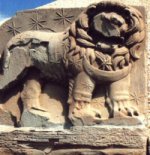
Nibiru Symbols
In Darkstar16 I looked at the depiction of Leo at Nimrud Dag in Turkey, and analysed the celestial positions of the stars on the frieze. It quickly became evident that the star shown within the upturned crescent moon could not be Regulus, as had previously been assumed. Instead, the placement of a star within a crescent presented us with a new possibility, that of the projected arrival of Nibiru in Leo.

The positioning of the other planets in the constellation allowed us to date this event to 2BC. What was unclear was whether this frieze was designed to predict an event, or to record one. Given the construction of a 'star shaft' at a different point in the mountain (1), it seemed likely that this Anatolian complex, dating back to about 60BC, was aimed at pinpointing the date of a future event.
That event, I proposed, was the expected appearance of Nibiru, a brown dwarf in an elongated elliptical orbit around the Sun, that was one and the same as the Messianic Star.
The Coin
In DarkStar9 we looked at two pieces of historical evidence that contained Dark Star symbolism. A 2nd Century Roman coin, dating to the reign of Emperor Pertinace, showed a goddess pointing to a celestial sphere with an unusual arrangement of 4 rays (2).
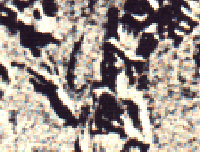
That this depiction might show the winged disc near Sirius is strengthened by the fact that a temple at Sippar contains a 'sun-disc' with 4 rays:
""During the Assyrian period many of the same Old Babylonian symbols for celestial objects persist on commemorative stelae, on temple walls, in cylinder seal impressions, and in formal contexts. A tablet that marks the restoration and refoundation of the temple of Shamash at Sippar displays the three main symbols - sun, moon, and Venus (Andy: I suspect that Dr Krupp's 'Venus' is the Sun, and the wavy-lined 'sun' is actually Nibiru in this trinity)- as a celestial stamp of approval upon the enterprise. Shamash is seated inside on a throne, and a large version of his wavy-lined, four-pointed sun disk rests upon a table." (3)
The Symbol of Shamash
Given that the 1st Century Romans had inexplicably re-launched the Persian cult of Mithras, a 'sun-god' whose ritual practices had much in common with Early Christianity, then it may be equally possible that this coin carries forward the very ancient tradition of the Mesopotamian winged disc. However, I would question the bland assumption that all these symbols represent the Sun.
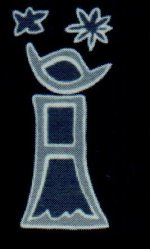
For instance, the shrine at Larsa devoted to the 'sun-god' Utu/Shamash is represented by quite different symbolism, that of 'the crescent-with-sun-disc on top of an altar or tower temple with water at its base' (4). This symbol includes two stars above the upturned crescent. The Egyptologist David Rohl notes that these depictions were often rotated to become more recognisable cuneiform symbols.
Thus, if we rotate this Shamash's early symbol from Larsa 180 degrees, we obtain a disc within a crescent, accompanied by two stars. We seem to have the archetypal Mesopotamian and ancient Egyptian winged disc, complete with its two uraei. These uraei are two 'divine cobras' that are often shown as smaller discs attached to the central disc by two wavy lines. All of these symbols, then, appear to have a common framework, and this is in keeping with the Roman coin.
The Amulet
The second piece of evidence was the Talisman of Orpheus, a 3rd Century amulet showing the crucified form of 'Orpheus Bacchus', representing the dying and rising god Osiris-Dionysus (5). Atop this Pagan Crucifix can be found seven stars in a crescent form and an upturned crescent in their centre. This evidence lends credence to my proposal that the Early Christian cults had at their core a remarkable celestial imagery which was later eradicated by the Roman Church.
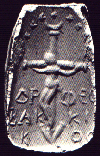
For the remainder of this page I will discuss the diverse symbolism associated with Nibiru. This will act as an introduction to Darkstar18 where I present a selection of Jewish and Pagan amulets from the Graeco-Roman period that, to my mind, definitively prove that Nibiru appeared during that era.
The Gem
This brings us to a new piece of evidence that consolidates further aspects of this diverse imagery. It takes the form of a Gnostic gem showing a lion-headed serpent. This strange image is connected with both Pagan and Early Christian imagery, being equivalent to the kosmokrator of the Roman cult of Mithras, of the Egyptian cosmic serpent Kematef, and the Hermetic deity Chnoubis. Its form includes symbolism clearly indicative of its celestial nature, linked with the First Decan of the Lion, and more generally with the Zodiac (6).
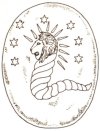
This particular gem has a set of rays eminating from the lion's head, and there is the familiar set of seven stars forming a semi-circle around Chnoubis. This allows us to compare this motif directly with that of the Talisman of Orpheus. This cosmic serpent was connected with the 'birth of the child of the aeon' and the unborn child, and was a form of an important Graeco-Roman goddess called Kore. Kore's festival in Alexandria fell on 6th January, an important date in the Early Christian calendar.
This is the 'Day of Lights' of the Baptism of Christ, the early Birthday of Christ and, these days, the Epiphany. So we can clearly see that this lion-headed cosmic serpent was associated by the Early Gnostic Christians with the celestial birth of a child, that took place within the First Decan of Leo.
This information all corroborates the theory that an anomalous 'star' first appeared in or near Leo and moved to its full brightness near Sirius (Kore). The head of the lion could be associated with its birth constellation, as well as indicating the regal nature of the 'star'. The wrapping of its body by a cosmic serpent showed how it was emerging from the darkness of the Primordial Deep. This Messianic Star, worshiped in various forms by the Egyptians, Early Christians, Hermeticists and Graeco-Romans alike, was Nibiru-Marduk, the 'Lost King' of the Jews and the 'Celestial Lord' of the Mesopotamians. It was symbolised as a dying and rising god, and ushered in the amalgamation of Jewish and Pagan beliefs that became Early Christianity.
Seven Monkeys
The seven stars were sometimes symbolised in other ways. An Egyptian portrayal of Horus, the falcon god, that appears on a papyrus dated to c.1350BC, shows a prominent red disc encircled by a cosmic serpent. This disc is surmounted by the familiar winged form. What is unusual is the inclusion of seven monkeys seemingly worshiping the disc of Horus (7).
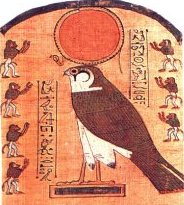
The Roman god Vulcan rode a celestial chariot pulled by two monkeys, and accompanied by a total of seven of these celestial primates (8). One of the monkeys was 'hidden' within the Hermetic imagery, possibly (although i suspect not) alluding to the loss of one of moons (the North Wind) during the Celestial Battle (9).
The fiery deity Vulcan was closely linked with the earliest alchemical studies, and I have begun my exploration of Nibiruan symbolism within Alchemy and Hermeticism in my paper 'The Secret Knowledge of Nibiru'.
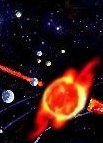
The Winged Disc often contains two small discs forming the heads of the
uraei. Does this allude to these two monkeys? I think this may be an
important clue. Of the seven moons described in the Enuma Elish, it
may be that two of them are more prominent visually than the others.
Perhaps these two are terrestrial-sized worlds in orbit around the dark star Nibiru, dwarfing their planetoid-sized siblings. One of them would presumably be the homeworld of the Anunnaki, the 'Seventh Star' or Seventh Heaven.
The Two Suns
Zecharia Sitchin has described the ceremonies conducted by the Mesopotamian priests during the advent of Nibiru in the heavens. The Akkadian texts that he cites note the simultaneous presence of 'the Sun disks' and the 'splendid/shining posts' (10).
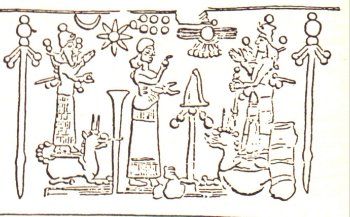
Evidently these references allude to the double sun discs of the Sun and the brown dwarf Nibiru in its perihelion excited state, while the shining posts are likely to mean the curved line of moons accompanying Nibiru. During the ceremony 7 of the Anunnaki line up before this heavenly spectacle:
"Anu then came into the courtyard accompanied
by gods in procession. "He stepped up to the Great Throne in the Akitu
courtyard, and sat upon it facing the rising Sun." He was then joined by
Enlil, who sat on Anu's right, and Enki, who sat on his left; Antu, Nannar/Sin,
and Innana/Ishtar then took places behind the seated Anu."
(10)
Notwithstanding the normal
associations of Ninnar/Sin with the Moon and Innana/Ishtar with Venus, the
inclusion of Anu and Antu as planets in their own right (appearing in the
'constellation Wagon') indicates this ceremony has an unusual connotation. I
suspect that, in this ceremony at least, these gods are representative of the
seven moons in the presence of the dark star Nibiru. The 'planet of Great
Anu of Heaven' would presumably be the homeworld of the Anunnaki. His
consort Antu creates a celestial pair. The rest of the gods bring the
total up to 7. This is what we are seeing in the other images depicting
Nibiru and its accompanying moons. A pattern is emerging.
The Garuda Bird
In my 2000 manuscript 'Winged Disc: The Dark Star Theory', I have looked at the diverse mythologies around the world that seem to contain hidden dark star symbolism. The ancient religions of the Indian sun-continent seem no exception, although the diversity of Hindu mythology potentially creates a high error margin. The Vedic god Indra seems to have parallels with Nibiru/Marduk, at least within the context of the Creation Myths. Another interesting piece of imagery is that of the Garuda Bird, riding upon which can be found the god Vishnu and the Goddess Lakshmi.

In Vishnu's head-dress and held in his hands are a total of 5 flowers and/or discs (11). Let us assume, then, that the mighty Garuda Bird represents the Phoenix, or Nibiru the fiery dark star. We then have two central gods riding upon this bird, equivalent possibly to Anu and Antu. Five further discs make the total to 7...
What is most interesting is the
mythological imagery associated with Vishnu himself. He has 10 avatars,
meaning 'one who descends', and these might allude to the return of this god at
the start of each aeon. Vishnu and Lakshmi are depicted seated upon a
Serpent of a Thousand Heads', again befitting a cosmic periodicity associated
with the change of Ages.
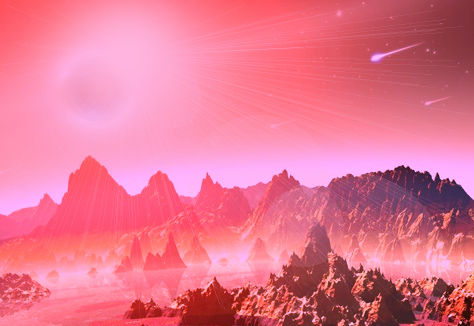
Perhaps these tie in with the Indian Yugas whose numeracy include the 3,600 year cycle of the Sumerian sexagessimal system. Most interesting of all is Vishnu's remarkable colour; blue. If Vishnu represents the homeworld of the Anunnaki orbiting the brown dwarf, then its terrestrial nature could be no better indicated than by this.
The heavenly moon would thus be a blue 'star' accompanying the reddish dark sun Nibiru. Perhaps it is the 'eye of Horus', the ancient Egyptian symbol of unrealised perfection. Unrealised or not, it appears to be the home of the gods themselves!
Did an ancient Bronze Artifact record Nibiru?
A ten-inch wide bronze disc recently discovered in Germany has helped archeologists to uncover mainland Europe's oldest-known observatory. The disc shows celestial imagery that dates back 3600 years, including a cluster of seven stars (the Pleiades?), the Moon and Sun, and an enigmatic crescent that has been officially dubbed a 'solar boat' (12).
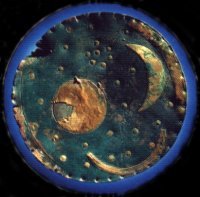
Lee Covino, who sent me a cutting from 'Archeology', the publication of the Archeological Institute of America, wonders whether the clear trinity of major celestial symbols might indicate Nibiru's inclusion (as the boat-like crescent), particularly given the inclusion of seven stars (its moons?), and the 3600 year dating. When this story first came out in early 2002 several other researchers wondered the same thing. Since then, 'Archeology' now reports, the celestial nature of this artifact has been confirmed by the excavation of a wooden observatory near the Harz mountain range in Germany that appears to have been functional for 1000 years (12).
So is the crescent-boat Nibiru (13)? If it is, this would be confirmatory evidence that the rogue planet appeared around 1600BC, and that its next perihelion passage is imminent. But I think that a more likely explanation is that the seven stars are indeed the Pleiades star cluster, and the 'solar boat' is symbolically representative of the constellation Taurus. The Sun and Moon then indicate the line of the ecliptic near the two. I suspect that the enigmatic crescent is neither Nibiru nor a 'solar boat', but instead represents an early Taurean symbol used in pre-Roman Europe.
But, on the other hand, it's perfectly possible that this ornate bronze disc was created to celebrate a rare and significant event, and the timing 3600 years ago is of crucial importance. Only time will tell.
Written by Andy Lloyd, 17th August 2001, and revised 13th January 2003
author of 'The Dark Star' (2005), 'Ezekiel One' (2009), 'The Followers of Horus' (2010) and 'Darker Stars' (2019)
Published by Timeless Voyager Press
References 1)
Adrian Gilbert "Magi: The Quest for a Secret Tradition" pp125-47, Virgin 1998
2) Peter Kolosimo “Not of
this World” pp66-73 Sphere 1970
3) E.C. Krupp "Echoes
of the Ancient Skies" p307, Oxford University Press 1983
4) David Rohl "Legend:
The Genesis of Civilisation" pp346-7 Arrow 1998
5) Timothy Freke & Peter Gandy
"The Jesus Mysteries" pp15-6, 64 Harper Collins 1999 6) Andrew Collins "Gods of
Eden" pp205-8 Headline 1998
7) Roy Willis (Ed.)
"World Mythology" p38 Duncan Baird 1996
8) Mark Hedsel,
David Ovason (Ed) "The
Zelator: A Modern Initiate Explores the Ancient Mysteries" pp104-5, 376 Arrow 1999
9) Zecharia Sitchin "The
Twelfth Planet" Ch 7, Avon 1976
10) Zecharia Sitchin "When Time Began"
pp110-4 Avon 1993 11) A. Cotterell (Ed.)
"Encyclopaedia of World Mythology" p147 Parragon 1999
12) "Star-Crossed Find"
Archeology, p21,
Jan/Feb 2003, thanks to Lee Covino and Joni Ferris
13) Andy Lloyd "The Dark Star: The Planet X Evidence"
Timeless Voyager Press 2005
![]() The Ultimate Encyclopedia of Mythology
The Ultimate Encyclopedia of Mythology![]() Símbolos Nibiruanos
Símbolos Nibiruanos